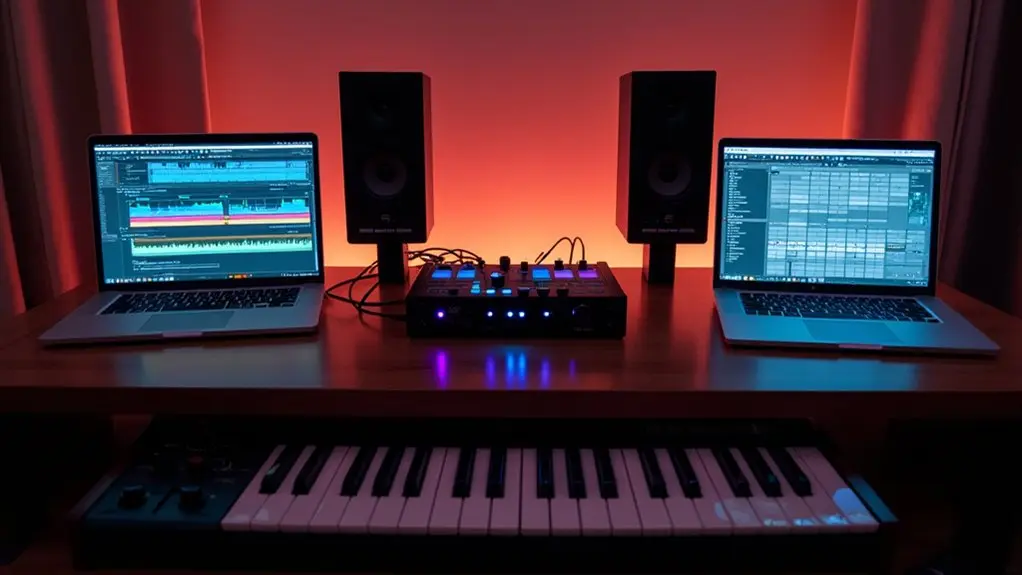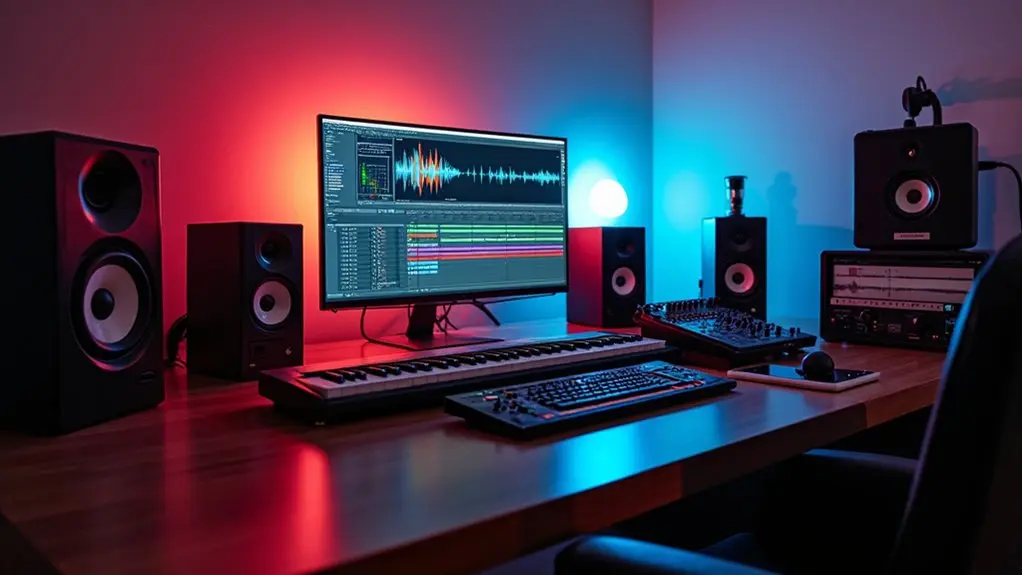Ableton’s Drum Rack enables creation of custom drum kits by loading personal samples onto up to 128 pads, organizing each cell with descriptive names for workflow clarity. Users sequence tailored drum patterns, extract precise one-shots, and apply effects directly to individual sounds or returns for enhanced sonic control. Advanced mixing includes routing pads to unique processing chains and integrating VSTs. Organized saving allows instant kit recall. Subsequent steps further optimize creative flexibility and advanced signal processing techniques.
Key Takeaways
- Populate Drum Rack pads with up to 128 unique samples by dragging and dropping sounds from your library for tailored custom kits.
- Rename and categorize samples within the Drum Rack for quick navigation and organized workflow during beat-making sessions.
- Save your custom drum kit using Drum Rack’s save function for easy recall in future projects from the User Library.
- Extract one-shot samples from loops, adjust start/end markers, and process each cell with individual or return effects for creative flexibility.
- Integrate VST effects and use Drum Rack Returns to route specific drum sounds for advanced mixing and sound design control.
Building Your Drum Kit With Personal Samples
While many producers rely on stock sounds, constructing a drum kit in Ableton using personal samples allows for a tailored and innovative approach to beat-making.
By dragging custom audio files directly from the computer into the Drum Rack’s left sidebar, users can populate up to 128 pads with unique samples on a single track.
Dynamic linking guarantees any edits to the original files are instantly reflected within the Ableton project, promoting efficient iterative workflows.
Renaming samples within the Drum Kit enhances navigation and organization, crucial for rapid sound selection during creative sessions.
Saving the custom Drum Rack streamlines future use, as it becomes accessible from the User Library.
Utilizing the Favorites feature further accelerates access to preferred folders, fostering a more experimental and responsive sound design process.
Adding FabFilter Pro-Q 3 into your mixing chain can enhance the clarity of your custom drum kits, allowing for precise frequency adjustments to ensure each element stands out in the mix.
Crafting Drum Patterns in the Drum Rack
Programming drum patterns in Ableton’s Drum Rack begins with the insertion of empty MIDI clips, providing a flexible workspace for precise rhythmic sequencing.
Within these clips, users can draw MIDI notes corresponding to individual Drum Rack cells, allowing targeted placement of kick, snare, hi-hat, or any custom sample. The left sidebar streamlines auditioning and selecting loaded samples, enhancing workflow efficiency.
Adjusting note velocities imparts expressive nuance, emulating the dynamics of live drumming. Users are encouraged to duplicate and evolve patterns, facilitating iterative arrangement and rapid development of complex drum sections.
Creative experimentation is key, utilizing Drum Rack’s capabilities for both straightforward grooves and intricate, evolving patterns.
- Access and audition loaded samples via the sidebar
- Draw MIDI notes for precise drum placement
- Adjust velocities for dynamic, humanized rhythms
- Duplicate and modify patterns for evolving sequences
Experiment with patterns in Session View for unique combinations, allowing for diverse and creative rhythm configurations.
Organizing and Renaming Drum Rack Elements
Streamlining the Drum Rack begins with systematically organizing and renaming its elements, an essential step for efficient navigation and precise sound identification. Within Ableton, users can right-click any drum sound or sample to rename it, applying descriptive labels such as “Snare Tight” or “Kick Deep.” This granular renaming enables immediate recognition even in intricate projects containing numerous drum sounds.
The left sidebar displays only the loaded elements, focusing the user’s attention and reducing visual clutter. By categorizing and organizing each drum sound—perhaps by instrument type or tonal quality—producers enhance workflow speed and minimize creative interruptions.
Utilizing the favorites feature for frequently used sample folders further accelerates access and organization, promoting a streamlined environment and encouraging creative experimentation with custom drum racks.
Saving and Recalling Custom Drum Kits
Efficiently saving custom drum kits in Ableton involves using the Drum Rack’s save function, which preserves the full configuration and samples for future sessions.
These saved kits are readily accessible in the User Library, facilitating rapid integration into new projects without setup repetition.
Consistent naming and organization of presets further streamline creative workflow, enabling producers to recall and experiment with their custom sounds across various productions.
Saving Drum Kits Efficiently
When developing unique sonic palettes in Ableton, saving custom drum kits is a crucial workflow practice that guarantees consistency and rapid recall across projects.
The process is streamlined: right-clicking on the Drum Rack and selecting the save icon stores the kit—complete with its structure and samples—directly into the User Library under Instruments > Drum Rack. This method preserves all sound design choices, enabling producers to revisit and reuse precise configurations without reconstruction.
Naming conventions play an essential role in this workflow, ensuring that each kit remains easily identifiable amidst a growing library.
Efficient saving drum kits routines underpin creative experimentation, freeing producers to focus on composition rather than asset management.
- Retains all individual sample choices and rack mappings
- Stores kits in the User Library for ongoing access
- Encourages robust naming systems for effective organization
- Minimizes setup time in subsequent creative sessions
Accessing Kits Across Projects
Once custom drum kits have been saved in Ableton’s User Library, the process of accessing and recalling them across multiple projects becomes highly efficient.
Users can locate saved drum kits either directly within the User Library or through the Instruments > Drum Rack section, enabling streamlined retrieval. Each preset retains its original structure and all loaded samples, ensuring sonic consistency when integrated into new sessions.
By simply dragging the desired kit onto a new MIDI track, producers can immediately reintroduce familiar textures and setups, supporting rapid workflow and encouraging creative experimentation.
Effective naming conventions further enhance this process by making kits easily identifiable, reducing time spent searching.
This seamless integration between saving and recalling kits empowers producers to build cohesive sonic palettes across diverse projects.
Organizing Presets for Workflow
Many producers rely on systematic preset organization to maintain creative momentum within Ableton.
Saving custom Drum Racks is accomplished by right-clicking the rack and using the save icon, storing the kit in the User Library or designated Drum Rack sections. This approach preserves the exact structure and samples, enabling rapid recall and consistent sound design across sessions.
Effective preset naming conventions are essential, allowing users to swiftly identify and retrieve kits without interrupting the creative process. Incorporating the Favorites feature further enhances workflow, granting immediate access to important sample folders and preferred Drum Racks.
This methodical organization supports both efficiency and creative experimentation.
- Save Drum Racks to User Library for reuse
- Apply clear, descriptive naming conventions
- Use Favorites for quick sample folder access
- Retain kit structure and samples across projects
Extracting One-Shots and Enhancing With Effects
Extracting one-shot samples from imported drum loops in Ableton involves isolating transient hits using precise start and end marker adjustments.
Once placed into Drum Rack cells, users can manipulate individual one-shots with track-specific effects, such as EQ or saturation, to sculpt their sonic character.
Creative workflows may also incorporate return effects for nuanced processing, enabling each drum element to occupy its own space within the mix.
Selecting One-Shot Samples
A critical step in custom drum kit creation within Ableton involves isolating one-shot samples from full drum loops by utilizing one-shot mode, which provides granular control over start and end points for targeted extraction.
This precision enables users to capture distinctive kicks, snares, or percussive hits, ensuring each sample fits the desired sonic palette. Once isolated, samples are easily mapped to new Drum Rack cells by holding the Alt (or Option) key while dragging, streamlining workflow efficiency.
Creative experimentation is encouraged through the application of high pass filters, which refine the extracted one-shot samples for enhanced clarity and separation within the mix. Utilizing Drum Rack Returns further personalizes each sample’s spatial and tonal characteristics.
- Adjust start/end markers for precise one-shot extraction
- Alt/Option-drag samples to new Drum Rack cells
- Apply high pass filters for frequency shaping
- Use Drum Rack Returns for further sonic customization
Applying Individual Track Effects
With carefully isolated one-shot samples mapped across Drum Rack cells, the process advances to enhancing each drum element through targeted effects processing.
Extracting individual hits from full drum loops involves utilizing one-shot mode in Ableton, where start and end markers define precise sample boundaries. Applying audio effects, such as high pass filters, further refines these sounds before placement in the Drum Rack.
For creative manipulation, users can copy samples to new Drum Rack cells by holding Alt or Option while dragging.
The Drum Rack’s Returns section is integral for applying individual track effects—reverb, delay, and other audio effects can be dragged here, enabling nuanced parameter adjustments like pan, mute, and volume per element.
This workflow maximizes creative flexibility and detailed mix control within custom drum kits.
Advanced Mixing and Processing Inside Drum Racks
Inside Ableton’s Drum Racks, advanced mixing and processing techniques empower users to sculpt individual drum elements with precision.
Producers seeking to find the sounds that define their custom kits can leverage the Returns feature for nuanced routing, sending selected drum cells to dedicated effects like reverb or delay. Each pad’s signal can be processed independently—drag effects into the Returns section to tailor pan, mute, and volume controls.
Filters, such as high pass filters, can clarify the mix by targeting frequencies on a per-sample basis, preventing frequency masking and muddiness. Creative manipulation is further supported by one-shot mode and sample duplication, encouraging rapid experimentation.
Key workflow strategies include:
- Route drum cells to custom Return chains
- Apply dedicated audio effects per sample
- Use filters for targeted frequency sculpting
- Duplicate and edit samples across pads
To ensure a seamless experience, enable VST2 Plug-In Custom option in Ableton and specify the path for the VST2 folder before rescanning to update the plugin list.
Frequently Asked Questions
How to Create a Custom Drum Rack in Ableton?
To create a custom drum rack, a user drags Drum Rack to a track, loads samples into rack cells, and assigns MIDI notes. Drum layering techniques enable creative experimentation, allowing intricate rhythms by stacking multiple samples on individual pads.
How to Add Sample to Drum Rack Ableton?
Adding a sample involves dragging audio from sample sources—either local folders or Ableton’s browser—into an empty Drum Rack cell. This workflow encourages creative experimentation, facilitating quick layering, manipulation, and organization of diverse samples within the rhythmic framework.
How to Create a Rack in Ableton?
Creating a rack in Ableton involves selecting the desired device category, then dragging a Rack onto a track. For ideal rack organization, users can group devices, label chains, and experiment with creative routing to streamline their production workflow.
Is an Ableton Drum Rack Good?
Evaluating the Drum Rack advantages, one finds its workflow-focused design, extensive sample capacity, and flexible routing empower creative experimentation. Dynamic sample linking, individualized sends, and streamlined organization collectively position the Drum Rack as a highly effective production tool.
Conclusion
Ableton’s Drum Rack empowers producers with precise control over custom drum kits, enabling seamless integration of personal samples, flexible pattern design, and efficient organization. By extracting one-shots, applying creative effects, and utilizing advanced mixing tools within the Rack, users can sculpt unique, professional drum sounds. Saving custom kits streamlines future sessions, fostering an iterative workflow. Ultimately, the Drum Rack serves as a dynamic platform for technical exploration and creative experimentation in modern music production.




